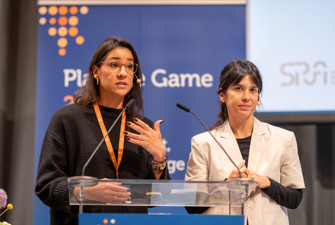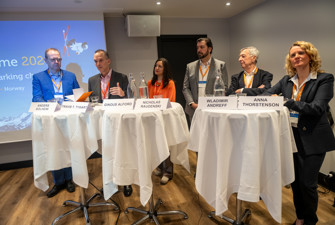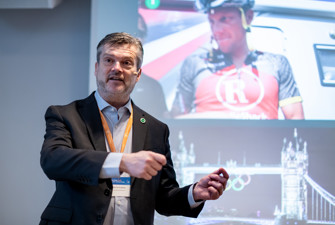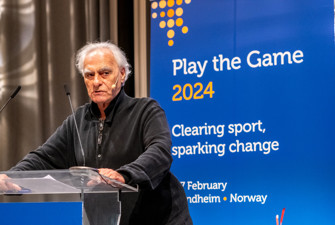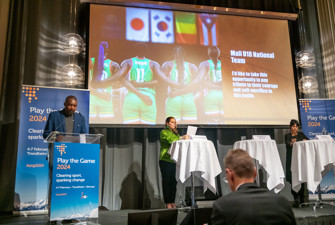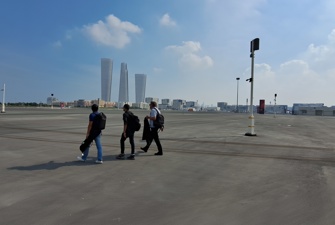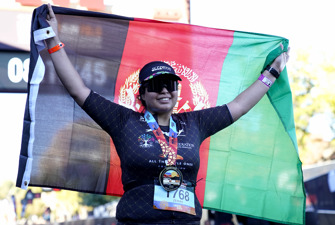Race walker Alex Schwazer continues his fight against sport's jurisprudence system
In a complicated case that dates back over six years, Italian race walker Alex Schwazer is asking the European Court of Human Rights to determine whether his human rights have been infringed as he cannot get a doping ban overturned, even though an Italian court has exonerated him of doping. Andy Brown lays out the latest development in the case where the stakes are also high for WADA.
The Italian race walker, Alex Schwazer, will be 39 when his eight-year doping ban expires on 7 July 2024. But he won’t be ‘marching’ again, to borrow the Italian definition of race walking. Instead, he’ll be fighting a new battle against the sporting jurisprudence system at the European Court of Human Rights (ECtHR).
The case doesn’t directly involve the Athletics Integrity Unit (AIU) of World Athletics or the World Anti-Doping Agency (WADA). But it does involve the sporting jurisprudence system, whose final court of appeal is the Court of Arbitration for Sport (CAS), located in Lausanne.
CAS decisions can only be appealed to the Swiss Federal Tribunal (SFT) which has already rejected Schwazer’s case, despite an Italian court ruling exonerating him of doping. Schwazer is arguing that Switzerland infringed the European Convention on Human Rights (ECHR) by failing to offer him any possibility of challenging his doping sanction despite his exoneration by an Italian court, which concluded that evidence had been manipulated in order to convict him.
In simpler terms, Schwazer is arguing that Switzerland has failed to correct a miscarriage of justice.
Schwazer’s filing has passed the assessment under Article 27 of the ECHR, which allows a judge to dismiss inadmissible claims without further examination. It has been assigned case number 24108/22.
Schwazer’s lawyers see this as a positive sign, as a high percentage of cases fail to clear this first hurdle. However, the case could still be declared inadmissible at a later stage after closer examination of the file.
But the case is not only important for Alex Schwazer. It is also critical for WADA, which has also been accused of procedural fraud by Italian prosecutors. If the ECtHR finds that sporting bodies did inhibit his right to a fair trial, and Switzerland infringed his human rights by failing to offer an effective remedy against that, then that could have serious consequences.
It would send a message to athletes that sport cannot guarantee athletes a fair trial, and Switzerland cannot protect their human rights from abuse by sporting bodies. In other words, that the sporting jurisprudence system to which athletes are bound cannot protect them from abuse.
A six-year battle to prove his innocence
“Over the last few years, I have learned not to be too optimistic,” Schwazer told Play the Game. “First, we have to win the appeal and only after this will I speak about the consequences.”
While some might view this as pessimism, it is not unfounded. After being accused of an anti-doping rule violation (ADRV) based on a single abnormal reading from tests conducted as part of his athlete biological passport (ABP) in 2016, Schwazer has been fighting to prove his innocence for six years.
Alex Schwazer wins the 50K race walk at the IAAF Race Walking Team Championship in Rome in 2016. Photo: Tullio M. Puglia/Getty Images
Netflix has recently released ‘Running for the Truth,’ a four part documentary that examines his six- year battle for justice, first detailed by Play the Game. The complex story has been examined by the courts in Italy, where intentional doping is a criminal offence.
In November 2020, the public prosecutor in Bolzano requested dismissal of a criminal case against Schwazer and in February 2021 the investigating prosecutor, Walter Pelino, cleared Schwazer of intentionally doping, concluding that Schwazer's 1 January 2016 sample had been manipulated.
As outlined in Play the Game’s original article, Pelino’s investigation uncovered gaps in the chain of custody; opposition to the transfer of the contested sample; the production of a ‘third tube’ of urine within the Cologne Laboratory; mixing of urine; discrepancies with the quantity of DNA in Schwazer’s urine sample; omission of evidence; and more. He therefore accused WADA and the International Association of Athletics Federations (IAAF - as World Athletics was then known) of ‘procedural fraud,’ a crime in Italy.
The response came in April 2022. The World Anti-Doping Agency (WADA) published an expert opinion from Martial Saugy of the University of Lausanne and a study commissioned by the AIU into whether DNA values in a 27 June 2016 sample taken from Schwazer that WADA had previously paid to analyse were implausible, as claimed by Italian prosecutors. These concluded that the sample had not been manipulated, and that DNA concentrations in urine vary wildly and had been observed at much higher levels than in Schwazer’s samples.
"To err may well be human (not in this case because there is, to say the least, bad faith), but to persevere is diabolical!" read a statement of reply from Schwazer’s lawyers, borrowing a Latin phrase.
"Insisting on phantom urine, without observing any procedure, with secret appraisals immune from contradiction betrays only a desperate attempt to justify an unjustifiable procedure seriously flawed from the beginning, violating every elementary principle of a fair trial, including arbitration. These initiatives from WADA deserve only contempt," the statement continued.
Recap part A: The samples from 1 January 2016
A recap is necessary in order to explain why the AIU and WADA felt it necessary to commission a DNA study.
A timeline of key events in the Schwazer case
1 January 2016
Urine sample taken from Alex Schwazer at his home in Racines, Italy.
Schwazer’s A and B urine samples locked in GQS offices in Stuttgart overnight.
2 January 2016
Cologne Laboratory receives Schwazer’s A & B samples from the 1 January test. Initial routine testing detects no prohibited substances.
5 March 2016
IAAF’s Athlete Passport Management Unit (APMU) flags Schwazer’s 1 January 2016 urine sample as ‘abnormal’ based on the results of subsequent samples taken from him.
28 March 2016
IAAF Athlete Passport Management Unit (APMU) requests GC/C/IRMS reanalysis of Schwazer’s 1 January A sample.
14 April 2016
Cologne Laboratory reanalyses A sample using GC/C/IRMS & initial screening finds it consistent with use of exogenous testosterone.
26 April 2016
Confirmation procedure confirms A sample result.
13 May 2016
Cologne Laboratory informs IAAF of A sample analysis result.
7 June 2016
IAAF produces documentation package relating to Schwazer’s sample.
21 June 2016
IAAF informs Schwazer of A sample analysis result.
5 July 2016
Cologne Laboratory’s analysis of Schwazer’s B sample confirms A sample result.
8 July 2016
Schwazer informed about B sample result and is provisionally suspended by the IAAF.
11-12 July 2016
Schwazer’s appeal to Italy’s national anti-doping tribunal against provisional suspension rejected (lack of jurisdiction).
18 July 2016
Court of Arbitration for Sport (CAS) rejects Schwazer’s appeal for provisional measures suspending his provisional suspension.
20 July 2016
CAS agrees expedited procedures due to proximity of Rio 2016.
8 August 2016
CAS hearing takes place.
11 August 2016
CAS sanctions Schwazer with 8-year ban.
23 December 2016
Tribunale di Bolzano, Italy, decides upon genetic analysis of Schwazer’s samples.
30 January 2017
CAS publishes full reasoning behind its 11 August decision.
13 October 2017
Cologne court of appeal orders transfer of Schwazer’s A and B samples to Italy following opposition from the IAAF & WADA.
17 October 2017
Tribunale di Bolzano hearing appoints expert to analyse Schwazer’s samples.
24 October 2017
World Athletics offers to provide 6ml from the B sample bottle rather than the 6ml left over from the 2016 analysis of his A sample.
11 January 2018
Bolzano prosecutor Pelino responds to World Athletics. WADA alleges that he doesn't mention its offer to provide 6ml from B sample bottle.
17 January 2018
Tribunale di Bolzano hearing agrees date for transfer of Schwazer’s A and B samples to Italy for DNA analysis.
7-8 February 2018
Transfer of Schwazer’s A and B samples from Cologne to Parma takes place.
March 2018
The DNA content of Schwazer’s sample is analysed in Parma - his B sample is found to contain three times as much DNA as his A sample.
18 May 2018
Note sent from Lausanne Laboratory to WADA detailing factors that could affect the concentration of DNA in Schwazer’s urine.
28 June 2018
WADA provides report detailing October 2017 DNA study on Schwazer’s 27 June 2016 sample to Italian expert Colonel Lago.
4 September 2018
Tribunale di Bolzano hearing.
14 September 2018
Tribunale di Bolzano hearing.
26 September 2018
WADA says it provided 2017 DNA study provided to Bolzano prosecutor Walter Pelino.
12 September 2019
Tribunale di Bolzano hearing - WADA cites 2017 DNA study.
14 September 2020
Tribunale di Bolzano hearing.
26 November 2020
Bolzano public prosecutor asks for the dismissal of criminal proceedings against Schwazer.
18 February 2021
Schwazer acquitted of intentional doping by Tribunale di Bolzano, which also accuses the IAAF and WADA of ‘procedural fraud’.
28 June 2021
Lausanne Laboratory publishes report confirming that DNA values in urine have been observed at higher levels than in Schwazer’s sample.
28 September 2021
Swiss Federal Tribunal rejects Schwazer’s appeal against CAS's decision to sanction him with an 8-year ban.
30 March 2022
Martial Saugy’s expert opinion commissioned by WADA is published, concluding that manipulation is unlikely.
As is usual practice in anti-doping proceedings, Schwazer’s 1 January 2016 urine sample was split into ‘A’ and ‘B’ bottles. Initial analysis of the A bottle took place in January 2016, where the sample was reported as negative. No prohibited substances were detected in the sample.
As previously revealed by Play the Game, Schwazer’s case was one of the first to be flagged under the urinary steroidal module of the Athlete Biological Passport (ABP). This monitors endogenous (internal) steroid levels in urine over time to detect any changes which might indicate doping involving the administration of exogenous (external or synthetic) steroids.
Subsequent samples provided by Schwazer led to the steroidal profile of his ABP being flagged as abnormal on 5 March 2016. After viewing the results of these other samples, the IAAF’s Athlete Passport Management Unit (APMU) decided that the 1 January 2016 A sample was an ‘outlier’. It found that the levels of steroids in that urine sample fell outside of Schwazer’s usual levels, observed in three other urine samples collected on 10 December 2015, 15 January 2016, and 24 January 2016.
The subsequent samples provided a baseline for Schwazer’s levels of endogenous steroids. The 1 January 2016 sample fell outside of those baseline levels and indicated possible use of exogenous steroids.
Reanalysis of the 1 January 2016 A sample using Gas chromatography combustion isotope ratio mass spectrometry (GC/C/IRMS) was ordered by the IAAF and was carried out on 19 April 2016. Using this more exact method, his sample returned a positive for exogenous steroids.
As is usual practice in anti-doping proceedings, Schwazer’s 1 January 2016 urine sample was split into ‘A’ and ‘B’ bottles. Photo: ullstein bild/Getty Images
Schwazer asked for his B sample to be analysed. His B sample confirmed the result of the re-analysis of his A sample. Positive for exogenous testosterone. He was provisionally suspended on 23 June.
Following an unsuccessful local appeal, a request to the CAS for provisional measures allowing him to compete at the Rio 2016 Olympics was rejected on 19 July. On 11 August 2016, the CAS sanctioned him with an eight-year ban for a second doping offence.
Recap part B: The fallout from whistleblowing
Schwazer had already been sanctioned with a two-year ban for EPO use in 2012. Following the Beijing 2008 Olympics, he reported his suspicions that competitors were doping to his medical team at the Italian athletics federation (FIDAL) but argues that nothing was done.
He alleges that this lack of action led him towards doping. Following his sanction, he turned whistleblower and gave evidence against FIDAL doctors Pierluigi Fiorella and Giuseppe Fischetto on 16 December 2015. Italian prosecutors discovered that this was the same date on which the IAAF commissioned the 1 January 2016 test that led to his positive test.
One might argue that this is coincidence. But in an attempt to prove he could succeed without doping, Schwazer had begun to train with athletics coach and anti-doping fighter Alessandro (Sandro) Donati, who since the 1980s had disclosed numerous Italian and international doping cases.
Donati had also been instrumental in the discovery of the infamous blood database on Fischetto’s computer, which had given the IAAF a major headache at a time when allegations of systemic doping were clouding athletics.
In addition, Fischetto had exchanged emails with Thomas Capdevielle, at that time the IAAF’s medical and anti-doping manager, from 4 April 2012. Italian prosecutors claimed that these indicated that both knew Schwazer was doping prior to his 2012 positive test for EPO.
In July 2020, the Bolzano Court of Appeal acquitted Fischetto and Fiorella, overturning a January 2018 verdict sentencing both to two years imprisonment for assisting Schwazer in blood doping. On 17 March 2022, the Tribunal of Rome found that Schwazer had not committed defamation against Fischetto by stating that he had been the victim of sabotage.
Recap part C: The appearance of a third tube of urine
As mentioned, doping is a criminal offence in Italy and following the 2016 CAS decision, Italian prosecutors launched a case against Schwazer. He immediately argued that his sample had been manipulated. Italian prosecutors ordered the transfer of his samples to Italy for analysis, after a Cologne court order forced their release.
The IAAF and WADA initially opposed the transfer of Schwazer’s A and B samples to Italy. WADA argued that the B sample only contained 6ml of urine, which was too small to conduct reliable DNA analysis.
When the transfer took place, Bolzano prosecutors described that a ‘diplomatic incident’ took place in the Cologne Laboratory, as detailed in Play the Game’s original article. In short, Italian prosecutors allege that a third, unsealed, tube of urine was produced in addition to the A and B samples.
The expert appointed by the Italian court to supervise the transfer discovered that Schwazer’s B sample actually contained 18ml of urine and not 6ml. The amount in the third, unsealed, tube that the Cologne Laboratory wanted to give to the Italian expert? 6ml. The same amount that the IAAF and WADA had initially claimed constituted his B sample.
The AIU and WADA argue that the 6ml in the third, unsealed, tube was what was left over from the 2016 analysis of Schwazer’s B sample. They point out that the Cologne appeals court had ordered that the 6ml tube must be handed to Italian prosecutors. However, this ignores the fact that Italian prosecutors had been told that the 6ml tube was the B sample, and its experts had warned that the 6ml tube presented by the Cologne Laboratory for transfer breached that court order because it was unsealed.
Schwazer’s representatives were present for the opening of the B sample back in 2016, but say they were not able to check the cap of the bottle because it was thrown away. This is significant because investigations into Russian state doping highlighted that sample bottle caps can be opened and resealed.
Following the objections of the Italian delegation, the original B sample was transferred. Analysis took place in Parma during March 2018. Three times as much DNA was found in the B sample as compared to the A sample.
This is a key point, as it led Italian prosecutors down the path of investigating whether Schwazer’s sample had been manipulated. An important reminder: Schwazer’s A sample and B sample both contain the same urine, taken from Schwazer on the same date, 1 January 2016.
The AIU DNA Study
The study commissioned by the AIU asked the Lausanne laboratory to measure the DNA concentration in 100 urine samples of approximately 6ml. It did this because Italian prosecutors had dismissed an October DNA 2017 analysis, which WADA had commissioned the Lausanne Laboratory to carry out on a 4ml sample collected from Schwazer on 27 June 2016, due to it containing improbable levels of DNA.
The AIU Study found that DNA concentrations in urine ranged from 0.001ng/µL to 20.183ng/µL. It therefore argues that it refutes a claim made by Italian prosecutors that a DNA concentration of 14.013ng/µL, found in the October 2017 analysis, was unusual.
The October 2017 analysis was performed by the same Lausanne laboratory that carried out the 2021 Study for the AIU. It found that DNA concentration in Schwazer's 27 June 2016 sample was higher than the one reported for his 1 January 2016 B sample. It was performed using 4ml of urine, despite WADA and the IAAF’s previous argument that over 6ml of urine was needed for DNA analysis - hence the opposition to the transfer of Schwazer’s B sample to Italy.
Bolzano prosecutors were critical of WADA’s October 2017 DNA analysis for a number of reasons. WADA conducted the DNA analysis before Italian prosecutors performed their DNA analysis of Schwazer’s sample in March 2018, and prosecutors argue that WADA waited until a September 2019 hearing to produce it as evidence. This is disputed by WADA which argues that prosecutors were provided with the study ahead of the hearing. Italian prosecutors argue that up until January 2018, only Schwazer and the IAAF should have been aware that DNA analysis was to be performed on the sample, yet WADA's October 2017 DNA analysis was performed before that.
However, as reported in Play the Game's original article, hacks performed by the Russian state organisation Fancy Bears revealed close communication between the IAAF and WADA about Schwazer's case. At that 2019 hearing, IAAF told Italian prosecutors that it was unaware of WADA’s 2017 DNA analysis. Yet emails show that the IAAF was aware of the intention of Bolzano prosecutors to analyse the DNA content of Schwazer’s sample on 31 January 2017.
Leaving all of the above anomalies aside, did the study commissioned by the AIU ask the right question? It has proven that DNA concentrations in urine vary considerably, even when they come from the same person. It hasn’t proved whether one bottle of urine can contain three times as much DNA as another bottle of the same urine taken on the same date, two years after the sample was collected and following possible degradation of DNA due to freezing. It has, arguably, failed to answer the key question.
Saugy’s expert opinion
WADA's response to the conclusions of the judge in Bolzano that Schwazer's sample had been manipulated came in the form of an expert opinion from Martial Saugy.
Martial Saugy, Director of Anti Doping Laboratory Switzerland. Photo: Jamie Mcdonald/FIFA/Getty Images
Martial Saugy is a scientific advisor to the Center of Research & Expertise in anti-doping sciences at Lausanne University. He is also the former director of WADA's flagship laboratory in Lausanne. He was replaced as laboratory director before WADA commissioned the Lausanne laboratory to perform the October 2017 DNA study of Schwazer’s sample, and before the AIU commissioned the same laboratory to perform its 2021 DNA study in support of WADA’s 2017 findings.
Saugy was previously involved in a controversial case when supervised the routine destruction of 55 samples relating to Russian athletes in March 2013, arguing that WADA had not instructed him to retain them. He also worked as a consultant at the Sochi 2014 Winter Olympics.
WADA asked Saugy to investigate several elements in judge Pelino’s theory:
- that a third person could have opened both the A and B samples and mixed Schwazer’s urine with that of another athlete who had tested positive for testosterone
- that prior to mixing, that urine was exposed to UV rays in order to eliminate the DNA signature
- that the final mixture was heated to resolve the problem of dilution of the urine through mixing and to ensure that a positive test was recorded.
WADA claims that Saugy’s expert opinion ‘establishes that the manipulation scenario devised by judge Pelino is wholly implausible and there is no analytical evidence of it.’
However, WADA didn’t ask Saugy to investigate whether the sample could have been manipulated at any stage in the process. It asked him about a specific manipulation scenario at a specific time. This scenario was just one of Pelino’s theories.
Saugy explains that under ordinary test procedures, heating the sample to evaporate liquid and concentrate the testosterone present may increase the likelihood of a positive. However, he argues that heating the sample would not have affected the GC/C/IRMS reanalysis of Schwazer’s A sample, performed at the Cologne Laboratory from 14 to 19 April 2016.
Saugy argues that this is because synthetic steroids will have a more depleted Carbon Isotope Ratio (CIR) signature than endogenous steroids. Heating and concentrating the sample wouldn’t affect those CIR signatures, which indicate synthetic steroids.
Scientists approached by Play the Game, who wished to remain anonymous, were also sceptical about whether heating the sample to cause evaporation would increase the chance of a positive test. However, they didn’t completely exclude the possibility that Schwazer’s positive test could be false.
They told Play the Game that free testosterone, which is not attached to proteins, is excreted in urine. Protein bound testosterone can be excreted in urine but is usually a sign of kidney damage. In theory, if urine is concentrated via heating or due to dehydration on the part of the athlete, this could cause any protein bound testosterone to unbind, resulting in a false increase in free testosterone in a urine sample.
A potential false positive. The above example isn’t the only way that this could occur.
Other scientists pointed to the work of professor David Cowan, head of the Drug Control Centre, Kings College (London Laboratory) during the Diane Modahl case.
In this case, a 2002 study found that microbial production of testosterone in urine stored at ambient temperature may cause a false positive test, even when GC/C/IRMS analysis is used. Specifically, it found that candida albicans, a pathogenic yeast common in humans, can produce testosterone at a microbial level within urine over time, causing that urine to record a false positive test.
Whether either of these scenarios could have occurred in Schwazer’s case is unexplored. Scientists said that both scenarios were extremely unlikely, and they were not raised by Schwazer’s defence.
"I consider the manipulation scenario of the judge to be extremely implausible and extremely unlikely to have occurred," concludes Saugy’s opinion.
"First, the very premise of the manipulation scenario (i.e., concentration to increase detectability) is flawed. Second, the lack of any indication of manipulation and compatibility of the positive sample with the athlete’s steroid profile are a very strong indication that no manipulation occurred. It strikes me as implausible in the extreme that a scientist with the sophistication to pull off the manipulation protocol without upsetting the athlete’s steroid profile would not have realised that concentrating the sample was a futile exercise."
That may be the case, but the GC/C/IRMS analysis took place in the Cologne Laboratory in April 2016. Almost two years later, in February 2018, the Cologne Laboratory attempted to give Italian prosecutors what the AIU and WADA claim was residual urine from this analysis in an unsealed tube. Italian prosecutors refused this residual urine and instead took the B sample, which the IAAF and WADA have clarified that they wished to retain in the Cologne Laboratory for future reanalysis.
The B sample was never supposed to arrive in Italy. It was this B sample which revealed the DNA discrepancies.
Still undetermined if Italy will prosecute WADA
In a 2021 statement, WADA points out that Schwazer has never disputed that his 1 January 2016 sample reported a positive test for testosterone. However, that is because he has consistently argued that it was the result of sabotage.
Schwazer has been cleared of criminal charges by an Italian court which found that evidence has been manipulated and has been cleared of allegations of defamation for claiming that he has been the victim of sabotage. Yet he is still subject to an eight-year ban. WADA has been accused of procedural fraud, and it has yet to be decided if Italian prosecutors will take this case forward.
Article 2.5 of the World Anti-Doping Code prohibits athletes from tampering with a doping sample. Article 10.9.3.3 treats it as an additional offence, with any ban imposed added to the end date of any doping sanction.
If the conclusions of Italian prosecutors are accurate, then the actions of the IAAF and WADA do appear to fall within the code’s definition of tampering. WADA polices athlete violations of the code via its own arbitration jurisprudence system but who would, in this hypothetical scenario, hold WADA to account?
Schwazer denied remedy due to lack of criminal conviction
This brings us to why Schwazer is challenging Switzerland at the ECtHR. Although he has been exonerated of doping by an Italian court, there is no effective remedy within the Swiss system for challenging his continuing sanction of ineligibility.
The eight-year ban ended Schwazer’s career. The Swiss Federal Tribunal (SFT) decided not to review the CAS award, despite the Italian ruling. Schwazer alleges that this breaches Article 8 of the ECHR, which enshrines respect for his private life, by failing to reopen proceedings based on new evidence which suggests a miscarriage of justice.
The Swiss Private International Law Act (PILA) governs arbitration proceedings, and Chapter 12 governs the revision of arbitral awards. Article 190a allows a person to seek revision of an award if new evidence is discovered that doesn’t postdate the award, or if criminal proceedings discover that the award was influenced to the detriment of the complaining party.
As can be seen, a criminal conviction is not a requirement. Schwazer’s situation appears to meet both of these criteria, yet Switzerland appears to have denied Schwazer the opportunity to seek a revision of the CAS Decision.
The SFT dismissed Schwazer's application because it reasoned that only criminal proceedings directly concerning the offence that is alleged to have influenced the CAS decision fall within the PILA.
Schwazer’s application to the SFT argued that tampering with urine samples constituted procedural fraud and other crimes under the Swiss Penal Code, which influenced the CAS decision to his detriment. However, the SFT reasoned that the decision on which is application was made concerned the dismissal of the criminal proceedings against him for doping, and not the uncompleted criminal proceedings for tampering with his sample.
‘The criminal proceeding must have as its object the punishment of the crime or offence that influenced the award,’ it wrote. The ECtHR will have to decide if this interpretation infringes Schwazer’s right to private life as enshrined in Article 8 ECHR because it is a failure to correct a miscarriage of justice.
Confused? So were several lawyers approached by Play the Game.
Forced arbitration
Athletes competing in elite sports often have to sign an Athlete Agreement to receive funding, under which they must agree to arbitrate any disputes at the CAS and not at a court of law. Ever since the Claudia Pechstein case, academics and lawyers have debated whether such arbitration agreements are valid, given that an athlete faces no choice but to sign the Athlete Agreement in order to continue competing.
The benefits and limitations of CAS are described in another Play the Game report from 2021.
The ECtHR is likely to consider whether Rule 38 of the IAFF 2016/2017 Competition Rules thereby contravening Schwazer’s right to a fair trial. As such, Schwazer’s case could have implications for the sporting jurisprudence system.
‘WADA stands by all the evidence it provided in this case,’ wrote a WADA spokesperson in reply to a list of specific questions. ‘Ultimately, justice was delivered for athletes.’ The AIU also declined to answer the same specific questions about the case.
The Schwazer saga shows certain aspect of sports jurisprudence clearly. Athletes are held to different standards than those applicable to the organisations that govern them.
Has Schwazer’s case delivered justice for athletes, as WADA claims? At what cost?
Alex Schwazer celebrates his gold medal in the men's 50km walk at the Beijing Olympics in 2008. Photo: Jamie Squire/Getty Images
Elite athletes have no choice but to accept sport’s closed jurisprudence system, which considers them guilty unless they can prove that they are innocent. Schwazer's case illustrates the expensive and extensive measures that sport can take in order to ensure that its charges stick. The ECtHR will have to decide whether this imbalance is so unfair that in Schwazer’s case, it has infringed his fundamental human rights.
Schwazer has spent a huge amount of time and money attempting to restore his reputation and integrity.
“I can go on and until I can’t go on, I will continue,” he says, spoken like a true race walker.
“I think that in the past, a lot of athletes were innocent. Not every athlete is guilty. Also, the institutions make mistakes. In every area where humans interact, errors are possible."
“A lot of innocent athletes have to quit because they do not have the financial resources to continue. Fortunately, I am still able to fight for my innocence. I want to go forward, like Pechstein did. We are examples for athletes who have been victims of false positive tests.”
Read also the article from the Sports Integrity Initiative: Alex Schwazer case: is a difference of opinion acceptable?






